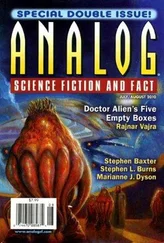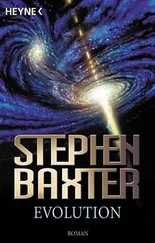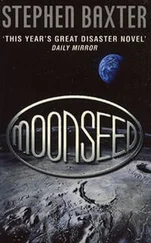Nemoto understood immediately.
“…Sulphuric acid. Of course. That is the key. What if these artificial lakes and rivers were once filled with acid? An acid biosphere is not as unlikely as it sounds. Sulphuric acid stays liquid over a temperature range three times that of water. Of course the acids dissolve most organic compounds — have you ever seen a sugar cube dropped in acid? But alkanes — simple straight-chain hydrocarbons — can survive. Or perhaps there is a biochemistry based on silicones, long-chain molecules based on silicon-oxygen pairs… Only a few common minerals can resist an acidic environment: quartz, corundum, a few sulphates. These walls have been weathered. Your mother would have understood… Venus is full of acid, you see. The clouds are filled with floating droplets of it. This is a good place to be, if what you need is acid…”
Carole gazed into the empty lake basins and tried to imagine creatures whose veins ran with acid. But this toy world, Nemoto had said, was hundreds of millions of years old. If any of their descendants survived they must be utterly transformed by time, she thought, as different from those who built this moonlet as I am from my mindless Mesozoic ancestors.
And if we found them — if we ever touched — we would destroy each other.
“…This bubble world is surely not meant to stay here, drifting around Venus, forever. We may presume that this was merely the construction site, Venus a resource mine. The bubble is already on a near-escape orbit; a little more energy and it could have escaped Venus altogether — perhaps even departed the Sun’s gravity field. You see?”
“I think so…”
“This rogue moonlet could travel to the nearer stars in a few centuries, perhaps, with its occupants warmed against the interstellar chill by their miniature interior Sun…”
They had been migrants to the Solar System, born in some remote, acidic sea. Perhaps they had come in a single, ancient moonlet, a single spore landing here as part of a wider migration. They had found raw materials in Venus’s orbit — perhaps a moon or captured asteroids — to be dismantled and worked. They had made more bubble worlds, filled them with oceans of sulphuric acid mined from Venus’s clouds, and sent them on their way — thousands, even millions of moon-ships, the next wave of colonization, continuing the steady diffusion of their kind.
“It’s a neat method,” Nemoto said. “Efficient, reliable. A low-technology way to conquer the stars…”
“Could it have been the Gaijin?” Carole asked.
“…But how convenient,” Nemoto was saying, “that these sulphur-eaters should arrive in the Solar System and find precisely what they needed: a planet like Venus whose clouds they could mine for their acid oceans, a convenient moon to dismantle. And where did the energy come from for all this?… Oh, no, Carole, these weren’t Gaijin. Whatever the secrets of this sulphuric-acid biology, it is nothing like the nature of the Gaijin. And this is all so much older than the Gaijin.”
Not the Gaijin, Carole thought, chilled. An earlier wave of immigrants, hundreds of millions of years in the past. The Gaijin weren’t even the first.
“We can’t know why they stopped before they had completed their project,” Nemoto said softly. “War. Cataclysm. Who knows? Perhaps we will find out on Venus. Perhaps that is what the Gaijin are here to discover.”
My mother’s generation grew up thinking the Solar System was primordial — basically unmodified by intelligence, before we crawled out of the pond. And now, though we had barely started looking, we found this: the ruin of a gigantic colonization and emigration project, ancient long, long before there were humans on Earth.
“You expected to find this,” she said slowly. “Didn’t you, Nemoto?”
“…Of course,” Nemoto said at last. “It was logically inevitable that we would find something like this — not the details, but the essence of it — somewhere in the Solar System. The violation. And the secretive activities of the Gaijin drew me here, to find it.
“One more thing,” Nemoto whispered. “Your data has enabled me to make a better estimate of the artifact’s age. It is eight hundred million years old.” Nemoto laughed softly. “Yes. Of course it is.”
Carole frowned. “I don’t understand. What’s the significance of that?”
“Your mother would have known,” Nemoto said.
Four hundred kilometers high, Carole was falling toward Venus. The lander had no windows; the conditions it had to survive were much too ferocious for that. But the inner walls were plastered with softscreens, to show Carole what lay beyond the honeycombed metal that cushioned her. Thus, the capsule was a fragile windowed cage, full of light, and her universe was divided into two: stars above, glowing planet below.
Her descent would be a thing of skips and hops and long glides as she shed her orbital energy. The sensation was so gentle, the panorama so elemental, that it was almost like a virtual simulation back on Earth. But this was no game, no simulation; she was really here, alone in this flimsy capsule, like a stone thrown into the immense air ocean of Venus, a hundred million kilometers from any helping hand.
Still she fell. The cloud decks below her remained featureless, but they were flattening to a perfect plain, like some geometric demonstration. Looking up, she could see a great cone of shining plasma trailing after her lander as it cut into the high air. She imagined seeing herself from space, a fake meteorite shining against the smooth face of Venus.
As her altitude unraveled the air thickened, and the bites of deceleration came hard and heavy, the buffeting more severe. Now the noise began; a thin screaming of tortured air, molecules broken apart by the heat of her descent, and there were flashes of plasma light at her virtual windows, like flashbulb pops. The temperature of the thin air outside rose to Earthlike levels, twenty or thirty centigrade.
But the air was not Earthlike. Sulphuric acid was already congealing around her, tiny droplets of it, acid formed by the action of sunlight on sulphur products and traces of oxygen that leaked up from the pool of air below.
At seventy kilometers she fell into the first clouds.
The stars winked out, and thick yellow mist closed around her. Soon even the Sun was perceptibly dimming, becoming washed out, as if seen through high winter clouds on Earth. Still the bulk of Venus’s air ocean lay beneath her. But she was already in the main cloud deck, twenty kilometers thick, the opaque blanket that had, until the age of space probes, hidden Venus’s surface from human eyes.
The buffeting became still more severe. But her capsule punched its way through this thin, angry air, and soon the battering of the high superstorms ceased.
Her main parachute blossomed open; she was briefly pushed back hard in her seat, and her descent slowed further. There was a rattle as small unmanned probes burst from the skin of her craft and arced away, seeking their own destiny.
The visibility was better than she had expected: perhaps she could see as far as one, even two kilometers. And she could make out layers in the cloud, sheets of stratumlike mist through which she fell, one by one.
Now came a patter against the hull: gentle, almost like hail, just audible under the moaning wind noise. She glimpsed particles slapping against the softscreen window: long crystals, like splinters of quartz. Were they crystals of solid sulphuric acid? Was that possible?
The hail soon disappeared. And, still fifty kilometers high, she dropped out of the cloud layer into clear air.
Читать дальше
Конец ознакомительного отрывка
Купить книгу











